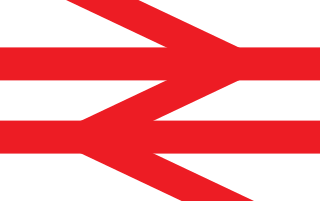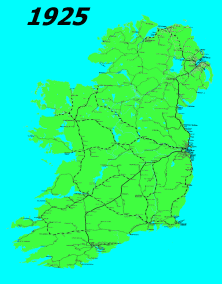
Belfast is the capital and largest city of Northern Ireland, standing on the banks of the River Lagan on the east coast. It is the 12th-largest city in the United Kingdom and the second-largest in Ireland. It had a population of 345,418 in 2021.
Most of the transport system in Ireland is in public hands, either side of the Irish border. The Irish road network has evolved separately in the two jurisdictions into which Ireland is divided, while the Irish rail network was mostly created prior to the partition of Ireland.

Transport in the United Kingdom is facilitated with road, air, rail, and water networks. A radial road network totals 29,145 miles (46,904 km) of main roads, 2,173 miles (3,497 km) of motorways and 213,750 miles (344,000 km) of paved roads. The National Rail network of 10,072 route miles (16,116 km) in Great Britain and 189 route miles in Northern Ireland carries over 18,000 passenger and 1,000 freight trains daily. Urban rail networks exist in Belfast, Birmingham, Cardiff, Edinburgh, Glasgow, Liverpool, London, Manchester and Newcastle. There are many regional and international airports, with Heathrow Airport in London being one of the top ten busiest in the world. The UK also has a network of ports which received over 486 million tons of goods in 2019. Transport is the largest source of greenhouse gas emissions by the United Kingdom.

NI Railways, also known as Northern Ireland Railways (NIR) ; and for a brief period Ulster Transport Railways (UTR), is the railway operator in Northern Ireland. NIR is a subsidiary of Translink, whose parent company is the Northern Ireland Transport Holding Company (NITHCo), and is one of seven publicly owned train operators in the United Kingdom, the others being Direct Rail Services, Northern Trains, Transport for Wales Rail, Southeastern, LNER, and ScotRail. It has a common Board of Management with the other two companies in the group, Ulsterbus and Metro.

Córas Iompair Éireann, or CIÉ, is a statutory corporation of Ireland, answerable to the Irish Government and responsible for most public transport within the republic and jointly with its Northern Ireland counterpart, the Northern Ireland Transport Holding Company for the railway service between the Republic of Ireland and Northern Ireland. The company is headquartered at Heuston Station, Dublin. It is a statutory corporation whose members are appointed by the Minister for Transport.

The United Kingdom consists of Great Britain and Northern Ireland, and previously consisted of Great Britain and the whole of Ireland. Rail transport systems developed independently on the two island masses of Great Britain and Ireland, and most of the railway construction in the Republic of Ireland was undertaken before the creation of the Irish Free State in 1922. Thus, the logical division to discuss the history and present-day state of railways in these areas is by geographical division, rather than the nationalist division of nation states.

The history of rail transport in Ireland began only a decade later than that of Great Britain. By its peak in 1920, Ireland had 3,500 route miles (5,630 km). The current status is less than half that amount, with a large unserviced area around the border area between Northern Ireland and The Republic of Ireland.

Rail transport in Ireland is provided by Iarnród Éireann in the Republic of Ireland and by Northern Ireland Railways in Northern Ireland.
Translink is the brand name of the Northern Ireland Transport Holding Company (NITHCo), a public corporation in Northern Ireland which provides the public transport in the region. NI Railways, Ulsterbus and Metro are all part of Translink. It is led by CEO Chris Conway.

Connolly station or Dublin Connolly is one of the busiest railway stations in Dublin and Ireland, and is a focal point in the Irish route network. On the North side of the River Liffey, it provides InterCity, Enterprise and commuter services to the north, north-west, south-east and south-west. The north–south Dublin Area Rapid Transit (DART) and Luas light rail services also pass through the station. The station offices are the headquarters of Irish Rail, Iarnród Éireann. Opened in 1844 as Dublin Station, the ornate facade has a distinctive Italianate tower at its centre.

Samson and Goliath are the twin shipbuilding gantry cranes situated at Queen's Island, Belfast, Northern Ireland. The cranes, which were named after the Biblical figures Samson and Goliath, dominate the Belfast skyline and are landmark structures of the city. Comparative newcomers to the city, the cranes rapidly came to symbolise Belfast in a way that no building or monument had hitherto done.

The Belfast–Derry line runs from Belfast to Derry in Northern Ireland. The line is double-track on the short section it shares with the Belfast–Larne line, but is composed primarily of single track from Monkstown to Derry with passing points at Templepatrick, Antrim, Magherabeg, Ballymena, Killagan, Ballymoney, Coleraine and Bellarena.

The Belfast–Dublin Main Line is a main and busiest railway route on the island of Ireland that connects Dublin Connolly station in the Republic of Ireland and Belfast Lanyon Place station in Northern Ireland. It is the only railway line that crosses the Republic of Ireland–United Kingdom border.

The Belfast suburban rail commuter network serves the metropolitan area of Greater Belfast and some of its commuter towns with three lines. The network is owned by Translink and operated by its subsidiary NI Railways.
EWAY is a bus rapid transit route being built in Northern Ireland to link the town of Dundonald in County Down with Belfast City Centre. If completed it will be about 5.5 miles (9 km) long.
Transportation systems in the city of Belfast, Northern Ireland include road, air, rail, and sea. It is still a relatively car dependent city however it is also served by a comprehensive rail and bus network. Belfast also ran electric trams prior to 1954. The city has two major airports and the Port of Belfast is the busiest ferry port on the island of Ireland.

Glider is a bus rapid transit system in Belfast, Northern Ireland, designed to improve the efficiency of mass transit in the city by connecting East and West Belfast and the Titanic Quarter via the city centre. The service is operated by Translink.
The Ballymacarrett rail crash occurred on 10 January 1945 at 7:50am in the Ballymacarrett area of Belfast, County Down, Northern Ireland on the Belfast to Bangor Line of the Belfast and County Down Railway, when a train led by a heavy autotrain driving trailer ran into the back of a stopped passenger train consisting of lightweight wooden coaches. 22 died with 27 injured. It was the worst crash in Northern Ireland since 1889. The cause was found to be carelessness of the driver of the autotrain who was running too fast for conditions. Fog, unsafe railway rules, and possible distraction from passengers all may have contributed to the accident. Old lightweight rolling stock contributed to the great number of injuries and deaths. The accident led to the demise of the railway which was nationalised three years later.











